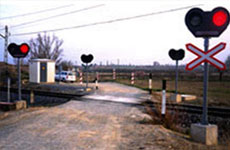
Categories
Publications
Problematic of level crossings on the 1,668 mm network and preventive action in 1975-2009
7/11/2014

Author/s: José Perlasia Giol
The problem of level crossings on the railway is as old as the construction of means of transport it had its origin in the need to divide farms , towns and cities to design the layout of it at the same time creating the need to cross them to move on either side thereof.
Thus for many years the railway authorities had only an agreement to establish gatekeepers in those steps affecting trunk roads , crosses from one side to another track in the cities and special cases.
The rest of the level crossings were limited to signals indicating saltire "Step unguarded . Service station " and trains have always had preference whereby numerous accidents steps were generated in this type of steps and even saved as most of them did not have the phone or side stations.
The first performances of automation modernization took place in 1954 and following that some railway lines León and Asturias and Galicia were equipped with Centralized Traffic Control and thus was forced to They could close the distance from said control before authorizing the passing trains .
It was not until 1978 when the new management of the State Ministry of Transport conducted jointly with RENFE that true transformation suppression and improved protection of level crossings are created.
This paper develops the actions carried out in the areas mentioned and the correlation between them, including the removal of level crossings and incredible gains in reducing accidents and loss of life is a performance, in general, little known in its significant magnitude.
Keywords: Gatekeeper, centralized traffic control (CTC), wire transmission, lifting barriers, sliding, automatic halfbarriers, interlocked halfbarriers, islands, pedals, planking, candlesticks, optical and acoustic.
Publication: Vía Libre Railway Research Nº 8 - November 2014, pp. 121-144
Download paper »


